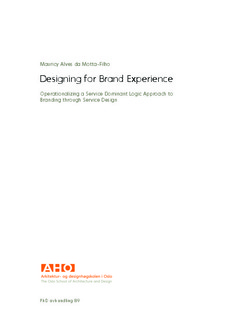Designing for brand experience : operationalizing a service dominant logic approach to branding through service design
Doctoral thesis
Permanent lenke
http://hdl.handle.net/11250/2446478Utgivelsesdato
2017Metadata
Vis full innførselSamlinger
- Design [33]
Sammendrag
This thesis reports on a research project that explored how Service Design could be used to facilitate the translation of Brand Strategy into Customer Experience. In this context, Designing for Brand Experience is proposed as a Service Design framework that operationalizes a Service Design approach to branding – namely, Service Branding; the process of translating the brand’s conceptual meaning proposition into customer experiences through tangible service interactions.
Accordingly, the Service Branding process is conceptualized as comprising of two interdependent phases defining and delivering the Brand Experience Proposition. Linking these two phases is the Brand Experience Manual – a tool used to inform the design teams what the experience they are designing for is, bridging the gap between Branding and Service Design. During the early stages of the empirical explorations, it was noticed that organizations were often unclear about their experience proposition, and as such, to create a Brand Experience Manual, it was first necessary to define the Brand Experience Proposition. Hence, the Brandslation process was developed so as to define the Brand Experience Proposition, informing the Brand Experience Manual.
Moreover, since Service Branding is also concerned with the delivery of the Brand Experience Proposition, the design of the enablers of the service interaction is also central to the Designing for Brand Experience framework. As such, by integrating different approaches to service development, the current research also proposes the Semantic Transformation for Experiences concept. This way, to operationalize the Service Branding process, the Designing for Brand Experience framework combined the three findings from the current research: the Brandslation process, which defined the Brand Experience Proposition; the Brand Experience Manual, which communicates the Brand Experience Proposition to the teams responsible for service development; and Semantic Transformation for Experiences, which facilitates the implementation of the Brand Experience Manual, enabling the design of brand-based customer experiences.
Developed through a Design Research methodology, the Designing for Brand Experience framework is the product of a practice-based research, grounded in an action research strategy, which evolved through cycles of design interventions and theoretical reflection. The empirical explorations centered on the development of the Brandslation process, and of the Brand Experience Manual in cooperation with the design consultancies, organizational partners, and master degree students. In total, there were four empirical iterations, resulting in an operational process for defining, and a tool for communicating the Brand Experience Proposition.
Later, during the final reflection stages, a model for translating the Brand Experience Proposition into the settings that support the brand-based service interaction was advanced. The findings from the current research add to both theory and practice – on the theoretical level, the research contributes to a richer understanding of the relationship between Service Design, Service Dominant Logic, and Branding, as shown by the Designing for Brand Experience framework, and the Semantic Transformation for Experiences concept; in practical terms, this research contributes to the realization of the Service Branding process, and to the development of brand-based customer experiences.
